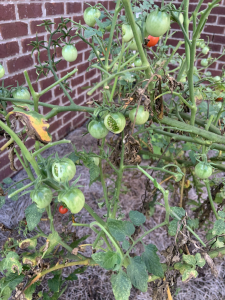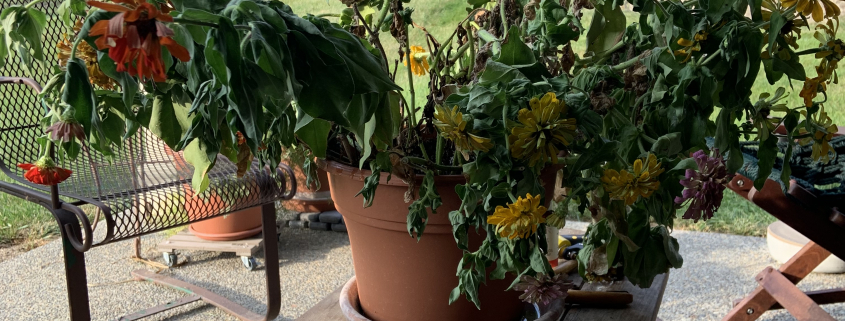Heat Exhaustion
A Labor Day weekend survey of the garden is a such a dreary exercise.
The petunias in the window box, big favorites of the hummingbirds and bees this summer, droop sadly in apparent surrender to the late-summer weather scourge. Their dry, twiggy stems are grumpily sprouting junior versions of their glorious purple trumpets from early summer. Patient daily watering does not appear to assuage their gloom or straighten their spines.
It has been generally miserable around here, as August in the South tends to be, when the old joke abbreviates the weather as HHH (hazy, hot, and humid). The plants are as irritable as the people as September arrives. The Gardener encountered a brief poem the other day that heralded September as the season of renewal. She briefly wonders where that poet resides but is pretty certain it ain’t around here.
A viney cherry tomato plant that hangs in a basket was a fun experiment this season for a warm sunny spot in the back of the house. The Gardener hung it on a pole and grinned at it all summer, thrilled at the candy-like flavor of its tiny red orbs. Then, as if the other maladies of August—storms, record heat, mold, and more amusements of that sort— were not sufficient to beat a Gardener into submission, the hornworms appeared. These vicious, naturally camouflaged attackers started at the top of the plant, working their way downward to shred the leaves and gobble the fruit. While the Gardener’s faithful back was turned, they transformed the proud green vines from robust to eligible for life support in an eye-popping 48 hours.
The first experience with hornworms was the stuff of nightmares. When poked, the sneaky, life-sucking little assassins rare up like a cobra and display tiny teeth. (No one could make this up. Seriously.) The Gardener was not proud of the satisfaction gained by ending Hornworm Reign of Terror with a sharp pair of garden shears for slaughter, but end it she did. Interestingly, Nature brooks no waste. The injured, half-bitten tiny tomatoes were hurled like Major League fastballs across the lawn toward the woods, more balm for the frustration. It was kind of fun to see the neighborhood flock of wild turkeys, strutting and clucking their grateful anticipation, descend on them like vultures on a roadside skunk. Can turkeys smell food? After watching these peaceful neighbors and their amusing habits for several seasons, the Gardener would not bet against it. 
As the heat wave continues, even the stalwart herbs beg for relief. A new variety this year with a tiny, pointed leaf and tart, lemony flavor, the basil plant bushed out beautifully and faithfully did its thing in support of the quintessential summer tomato salad. As if on cue last week when we hit 99 degrees, the basil suddenly sprouted a cluster of flowers on the tips of the stems as thick as the wildflowers in the meadow beyond the house. The butterflies are enchanted by the little blossoms, and even the hummingbird is happily sucking away, but this sight holds no joy for the Gardener. She reads the message clearly: Basil is done for the summer.
Saddest of all—as pitiful in its decline as it was glorious at its peak– is the potted giant zinnia, nearly the size of a bush. This happy one brightened the porch all summer. The fat, fluffy blossoms of red, orange and yellow summoned the hummingbirds, who cheered the Gardener with daily visits outside the office window. Zinnias are a gardener’s safe harbor in the hot Southern summer. They are reliably heat tolerant and last so well in a vase when cut. But after this latest brutal siege, even a major morning dose of water doesn’t bolster the zinnia to stand up in the heat by mid-afternoon.
The Gardener knows just how it feels.
Yet there is no rest for those who cannot relinquish optimism when faced with these signs of pestilence, drought, and tragedy. The lifelong Gardener is either the most determined optimist you ever met, or an oblivious idiot, or somewhere combination of both (OOI). The owner of our best local garden center writes an informative weekly blog about our conditions and the opportunities they represent to us OOIs. “You can plant now!” He promises. “The nights are getting cooler! Plants will grow and thrive until the ground freezes solid. It’s not too late. There is plenty you can do.” (And to nudge that concept along, all plants are on sale, of course.)
Feeling the 90-plus degree sun on her sweaty neck as she surveys available bed space on the holiday, the Gardener is inclined to dispute this advice and write it off to blatant commercialism. She commences to poke around for evidence in support of surrender, and that she is right, and he is wrong (because why trust an expert?). Sure enough, dadgum it, here is the sight, on closer inspection, of small green sprouts emerging near the bases of the tired petunia vines. Poking a toe in exasperation at the black-spotted, rotting leaves where the Shasta daisies sprouted eagerly earlier in the summer, she can see fresh, green leaves popping up at the base of the rotted ones.
Maybe, just maybe it is too early to surrender, after all?
As the Gardener stands absorbing these little surprises, she begins to contemplate a quick run to the garden center, eternally alert to potential bargains and intent on scoring that alluring 15 percent off for just the right things to fill the open spaces in that bed. Why not listen to the experts, after all? If the poets consider it the season of renewal, who is the Gardener to argue? Lost in these fantasies, she looks down to see that a tiny butterfly, brilliant orange and black, has taken a brief rest on the toe of her garden sandals.
Surely, this is a sign. Sometimes the Gardener takes comfort in considering that her beloved late mother, her mentor as a Gardener, might be manifesting encouragement to her in the forms of the hummingbirds and butterflies. An OOI down to the marrow of her bones, she does not care if this sounds crazy. She heads inside in search of her car keys.



